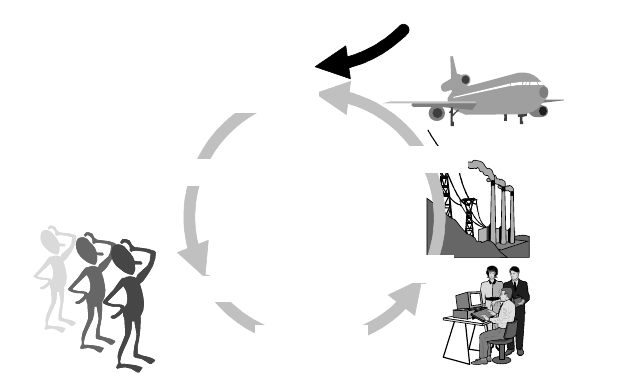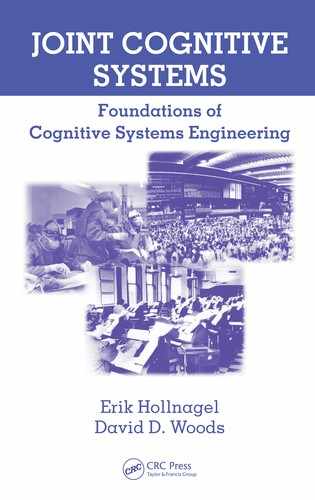16 Joint Cognitive Systems
The cognitive viewpoint also describes human performance as iterative or
cyclic rather than as sequential. Cognition does not necessarily begin with an
external event or stimulus; neither does it end with an action or response.
This is in good correspondence with the perceptual cycle proposed by
Neisser (1976). In CSE the perceptual cycle has been combined with the
principles of the cognitive viewpoint to provide the basic cyclical model
(Figure 1.7). The cyclical view explicitly recognises that meaningful human
action is determined as much by the context (the task and the situation) as by
the inherent characteristics of human cognition. Cognitive systems do not
passively react to events; they rather actively look for information and their
actions are determined by purposes and intentions as well as externally
available information and events. The mistake of the sequential view is easy
to understand because we are so readily hoodwinked into observing events
and reactions and interpreting them using our deeply rooted model of
causality. Yet an observable action does not need to have an observable event
as a cause; conversely, an observable event does not necessarily lead to an
observable action.
THE CLASSICAL HUMAN-MACHINE VIEW
Human information processing tended to focus on the ‘inner’ processes of the
human mind and to describe these isolated from the work context in the
tradition established by Wilhelm Wundt (cf., Hammond, 1993). This trend
became stronger as time went by, partly because the proliferation of
computers suddenly created a new population of users that were non-
professional in the sense that they had not been specifically trained to deal
with complex technology. This led to human-computer interaction as an
independent field of study, which was practiced by people who had little or
no experience from the processes and industries where human-machine
interaction traditionally had been pursued. New generations of researchers
and developers readily adopted the established mode of thinking and focused
primarily on the interaction between the user and the computer with little
concern for what might exist beyond that, except as an application layer. In
practice this meant that there was no process over and above the human-
computer interaction. The applications were in most cases driven by inputs
from the user rather than having their own dynamics. Thus office and
administrative applications came to dominate over process industries, power
plants and aviation.
The essence of the classical human-machine view is shown in Figure 1.6,
which, by using the simplest possible representation of each system as input,
processing, and output functions, clearly shows the two main characteristics
of the classical view. First, that the interaction is described exclusively as the
exchange or transmission of input and output. Second, that humans and

The Driving Forces 17
machines are described in the same fashion, using the finite state machine as
a basis. Technically speaking, the classical human-machine view represents a
closed-loop control system in the tradition of the Shannon-Weaver paradigm.
MachineHuman
Output
(Displays)
Input
(Controls)
Input
(Information)
Output
(Actions)
Information
processing
State
transitions
Interface
Figure 1.6: The classical human-machine view.
The Disintegrated View
The decomposed human-machine view became so accepted that the
distinctive issue became interaction with the interface (computer) rather than
interaction through the interface. The separation between humans and
machines achieved the status of a real problem as shown by Norman’s
notions of the gulfs of evaluation and execution (Norman & Draper, 1986)
and the very idea of usability engineering (Nielsen, 1993), and it became
almost impossible to see it for what it really was – an artefact of the
psychological application of the Shannon-Weaver model. Interface design
became an important issue in and of itself where, for instance, the graphical
user interface was seen as a problem in its own right rather than as something
that played a role in how a user could interact with and control a process or
application. The most recent example of this view is the notion of perceptual
user interfaces (Turk & Robertson, 2000), which steadfastly continues the
existing tradition, for instance, by focusing on the perceptual bandwidth of
the interaction (Reeves & Nass, 2000). Yet the Shannon-Weaver
communication paradigm was designed in order to deal with functioning of a
communication system. In the context of human and machine working
together we should be more interested in how the joint system performs than
in how the parts communicate. While the communication between the parts
and the interaction between humans and machines remain important topics,
making these the dominating perspective or focus misses the more important
18 Joint Cognitive Systems
goal of understanding how the joint system performs and how it can achieve
its goals and functions.
With the gradual change in terminology from human information
processing to cognition and cognitive functions, the processes that mediated
the responses to events became known as ‘cognition in the mind’. Although
cognitive science embraced the belief that cognition was computational, it
was eventually realised that ‘cognition in the mind’ did not occur in a
vacuum, but that it took place in a context or that it was ‘situated’. Actions
were no longer seen as exclusive outcome of mental activities, but rather as
closely intertwined with artefacts and formations of the environment –
including other people, of course. This became known in its own right as
‘cognition in the world’, and the use of tools and artefacts became a central
activity in the study of applied cognition (Hutchins, 1995). Complementing
‘cognition in the mind’ with ‘cognition in the world’ overcame one limitation
of human information processing but retained the focus on the cognition of
the individual as a substratum for action rather than looking to the quality of
action and the ability of the joint system to stay in control.
The disintegrated view reflects the assumptions of the sequential
information processing paradigm in two different ways. The first is that the
predominant models for cognition in the mind are sequential or procedural
prototype models (Hollnagel, 1993b). The second is that actions are seen as
responses to events, mediated by internal processes and structures. This view
has several specific consequences, which are acknowledged to be important
for the understanding and study of humans working with technology.
• Actions are treated as a series of discrete events rather than as a continued
flow of events. Yet it takes but a moment’s reflection to realise that what
we do always is part of one or more ongoing lines of action and that one
therefore should not consider actions one by one.
• Users are seen as single individuals. In practice, however, humans rarely
work alone. Humans are always involved with and depending on other
humans, even though they may be removed in time and space.
• The proactive nature of actions is neglected and the focus is on response
rather than on anticipation. Yet human action is more often than not based
on anticipation rather than simple (or even complex) responses.
• The influence of context is indirect and mediated by input. Yet in reality
we know that context has a decisive influence on what we do and how we
behave, even if that influence sometimes may be hard to spell out.
• Models are structural rather than functional. For instance, information
processing models focus on how information is stored and retrieved rather
than on the ability to remember and recall.
The Driving Forces 19
CHANGING THE PARADIGM
The many problems of the disintegrated view can only partly be overcome by
compensating for them via more complicated model structures and functions.
Sooner or later the fundamental flaws will have to be confronted. Instead of
trying to solve the specific problems one by one, the solution lies in
understanding the common root of the problems, and to overcome this by
proposing an alternative, integrated view. This is more than a play with
words, but signifies a fundamental change in the view of how humans and
technology work together. The integrated view changes the emphasis from
the interaction between humans and machines to human-technology
coagency, i.e., joint agency or agency in common. Agency is here used as a
verb describing the state of being in action or how an end is achieved, i.e.,
what a system (an agent) does.
We have argued above that the gulfs of evaluation and execution exist
only because humans and machines are considered separately, as two distinct
classes or entities. While it is undeniable that we, as humans, are separate
from machines, the physical separateness should not lead to a functional
separateness. The physical separateness was reinforced by the Shannon-
Weaver paradigm, which was developed to describe the communication. Yet
for CSE it is more important to describe the functioning of the joint cognitive
system, hence to join human and machine into one.
Figure 1.7 illustrates the focus on joint system performance by means of
the cycle that represents how the joint cognitive system maintains control of
what it does. The cyclical model is based on the ideas expressed by Neisser’s
description of the perceptual circle (1976), and the basic cycle of planning,
action, and fact finding in the ‘spiral of steps’ description of purposeful
action (Lewin, 1958). The model aims to describe the necessary steps in
controlled performance, regardless of whether this is carried out by an
artefact, a human being, a joint cognitive system, or an organisation, and it is
therefore also called a contextual control model (Hollnagel, 1993b).
The cyclical model has several specific consequences for the study of
how humans and machines can work together. These are considerably
different from the consequences of the sequential view, and deliberately so.
The net outcome is that the cyclical view offers a better basis on which to
study human-technology coagency.
• Actions are seen together. The cycle emphasises that actions build on
previous actions and anticipate future actions. Human behaviour is
described as a coherent series of actions – a plan – rather than as a set of
single responses, cf., Miller, Galanter & Pribram, 1960.
• Focus on anticipation as well as response. Since the cyclical model has no
beginning and no end, any account of performance must include what

20 Joint Cognitive Systems
went before and what is expected to happen. The cyclical model
effectively combines a feedback and a feedforward loop.
Process /
application
/ controlled
system
Events /
feedback
Action
Construct
Determines
Modifies
Controller /
controlling
system
Disturbances
Produces
Figure 1.7: Basic cyclical model (COCOM).
• Users are seen as parts of a whole. The cyclical model focuses on
coagency, on how users and environments are dynamically coupled, and
on how actions and events are mutually dependent.
• Influence of situation or context is direct. In the cyclical model, context
can affect the user’s way of working – specifically how events are
evaluated and how actions are selected, representing the fact that users
may have different degrees of control over what they are doing.
• Models are functional rather than structural. The cyclical model makes
minimal assumptions about components, hence about information
processing. The emphasis is on performance rather than internal
processes.
After the hegemony of the human information processing paradigm it
may come as a surprise that the perspective on human action as being tied
together, as continuous rather than discrete, is far from new. The criticism
that CSE directs against the human information processing view is very
similar to the criticism that functionalism directed against structuralism in the
1920s. This can be illustrated by the following quotation from a psychology
textbook by H. A. Carr:
Every mental act is thus more or less directly concerned with the
manipulation of experience as a means of attaining a more effective
..................Content has been hidden....................
You can't read the all page of ebook, please click here login for view all page.
